(7 images) Larus fuscus fuscus (?) 2cy, July 09-17 2003, Tampere, Finland (61.33N 24.59E).
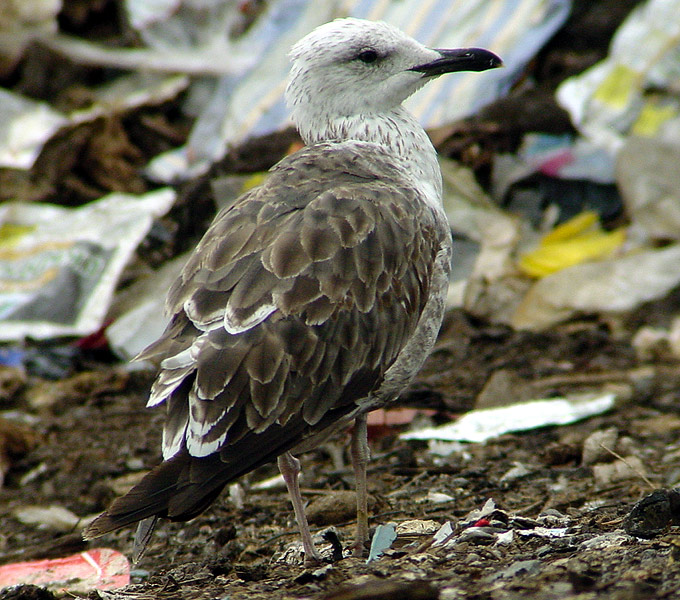 July 09 2004 July 09 2004
Some 2cy birds on the Tampere dump in Finland in July show characteristics which normally do not associate with classic fuscus, yet these birds are still believed to be nominate fuscus. Here is an individual with very restricted post-juvenile moult. By mid-July, the primary moult stage is just in line with other NW European gull taxa. July 09, P1 is growing and P4-P10 are still juvenile. By July 17, P1-P2 are growing, P3-P4 are missing and P5-P10 are still juvenile. All rectrices and secondaries are still juvenile as well and probably the moult in the flight feathers will take place in an ordinary sequence as in intermedius / graellsii.
All the scapulars were included in the post-juvenile moult on the wintering ground. The scapulars show a mix of old and new feathers (in the lower upper scapulars); the new scapulars show a dark centre on a dark brown base.
Some wing-coverts have been replaced on the wintering ground, now old worn second generation feathers, most similar to the old second generation scapulars. Tertials 1-3 were included, greater coverts 2-4 were replaced, #5 is still juvenile and very recently the central greater coverts were dropped. New greater coverts grow in from #6 outwards, with the last few greater coverts still juvenile. The median and lower lesser coverts show a mix of old and new second generation coverts as well, the old feathers worn at the fringes, the new feathers darker grey-brown. Normally, when wing-coverts are included in the post-juvenile moult, these earlier replaced coverts are left out in the first phase of the complete moult, so first the adjacent juvenile feathers are replaced. The largest amount of juvenile feathers can be found in the lesser coverts, especially in the carpal edge.
Moult score overlaps with average intermedius/graellsii in July in NW Europe (see July section), but see e.g. this advanced LBBG in the Netherlands, with P6 fully grown and P7 growing.
Typical Finnish fuscus in July have replaced primaries, rectrices and secondaries, all moulted in a complete post-juvenile moult on the wintering grounds, prior to northbound migration. The new second generation primaries are only a couple of months old and still look dark blackish. The second generation tail-feathers normally still show the white tips, but in some individuals these tips are worn away when 2cy birds arrive back in Scandinavia. Immediately after returning in Scandinavia some 2cy fuscus start a new moult cycle in the inner primaries, now growing in third generation feathers.
The complete moult in the winter quarters normally start with replacement of the scapulars and mantle-feathers in November to January, but the post-juvenile moult may already start in juvenile birds which are still in Scandinavia in September. The new scapulars often show a simple pattern of a black shaft-streak on a dark brown base. When most of the scapulars are replaced, fuscus start to replace the wing-coverts, in the ordinary sequence that can also be found in other gull taxa in Europe. Wing-covert moult is initiated in two loci, one wave starts in the outermost coverts, one wave starts in the innermost coverts. The two waves normally meet at covert #7-8. Normally the median covert row is the first row which is moulted, followed by the lower lesser coverts, the greater coverts and moult finishes in the outer lesser coverts (the carpal edge). If for whatever reason, moult in the wing-coverts is arrested, this is normally most obvious in the carpal edge and outer greater coverts, containing juvenile feathers which contrast with the other fresh coverts.
In classical 2cy fuscus, all wing-coverts are replaced to second generation on the wintering grounds, and by mid July in Scandinavia, a next moult wave is initiated, often including the median and lower lesser coverts, the inner greater coverts, upper tertials and scapulars. Bare part coloration may be very immature, including a black bill, but may also be very mature, with a yellow base and a red gonydeal spot on the lower mandible. Still, these birds are only 12 months old.
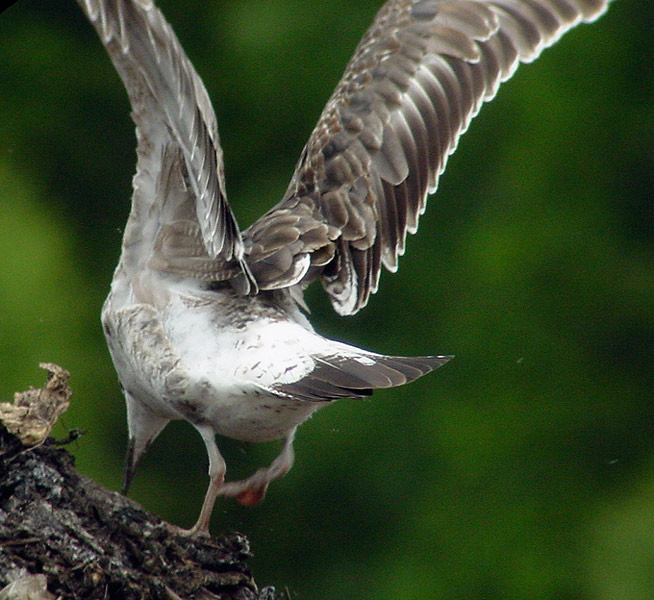 July 09 2004 July 09 2004
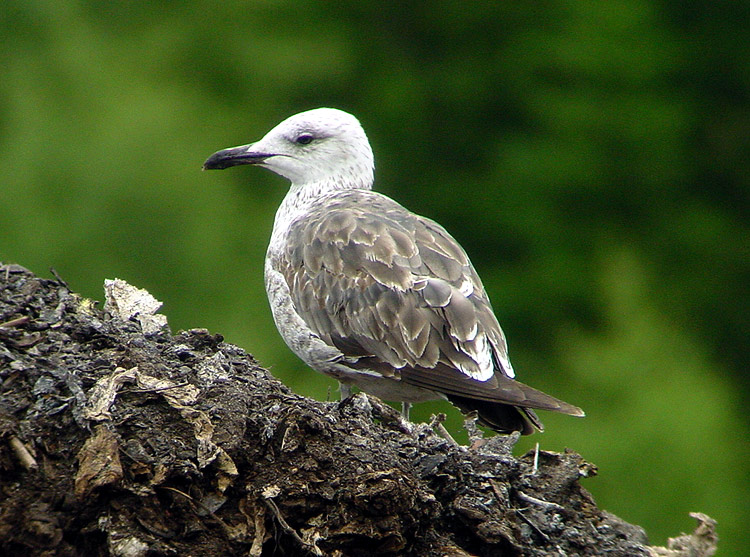 July 09 2004 July 09 2004
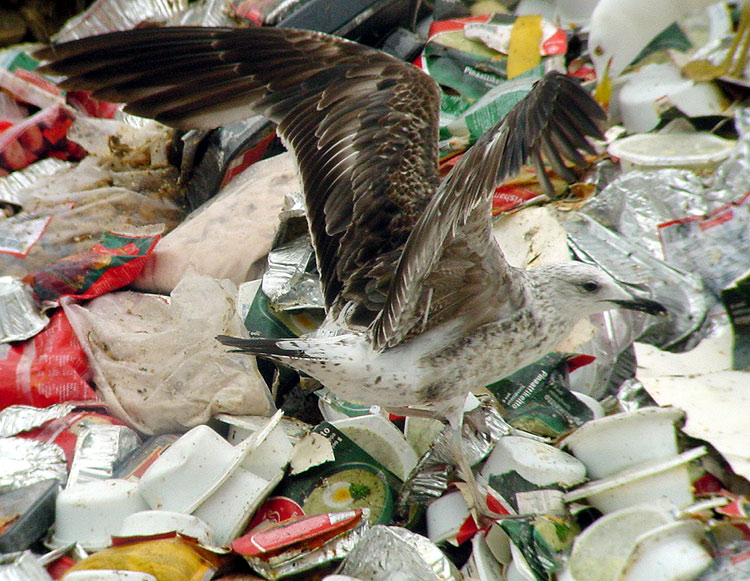 July 09 2004 July 09 2004
 July 09 2004 July 09 2004
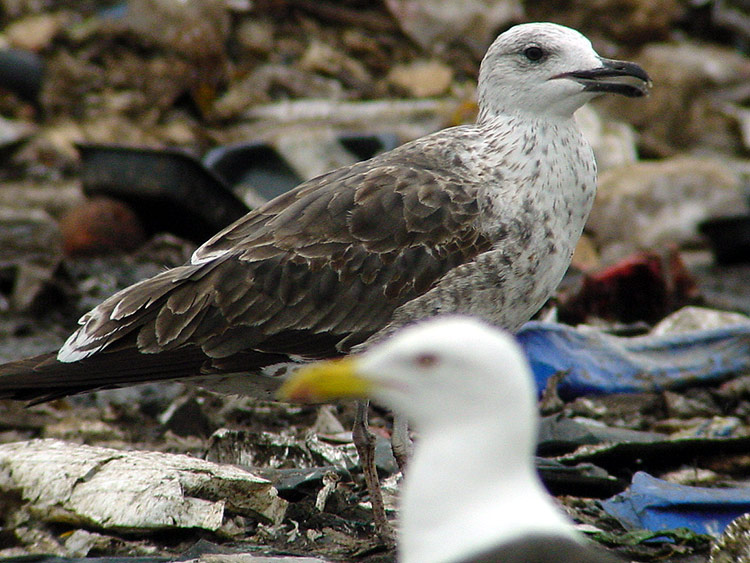 July 11 2004 July 11 2004
 July 11 2004 July 11 2004
|
 nominate Lesser Black-backed Gull (L. fuscus)
nominate Lesser Black-backed Gull (L. fuscus) July 09 2004
July 09 2004 July 09 2004
July 09 2004 July 09 2004
July 09 2004 July 09 2004
July 09 2004 July 09 2004
July 09 2004 July 11 2004
July 11 2004 July 11 2004
July 11 2004